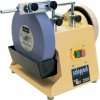I have had, and use this Grizzly slow speed 10" wet grinder since the late 1980's. It's been in continuous use, because I'm a believer in it's usefulness for putting a sharper edge on bowl gouges.
I always use the 1825 rpm Delta 8" grinder to put a basic edge on my bowl gouges. I currently have the Norton 80gt blue wheels.....expensive, but cool running and very aggressive. The basic grind is done no differently than most of you are doing it. I use a wolverine jig, with V arm, and vari-grind jig. From the Delta grinder, the gouge goes to the Grizzly wet grinder, and after that's done, I use a slip stone, ceramic stone, or a round diamond hone to clean up the top edge, or inside the flute.
I've found that the slow speed wet grinder hones a sharper edge on bowl gouges than that which comes directly from the Delta dry 8" grinder. This is NOT hocus-pocus here, because I've done the testing to see if it's true. Take any hard cutting wood and do a test cut with your gouge both ways......I've found the wet grinder produces a sharper edge, which makes a better, cleaner cut.
I no longer use the wet grinder for scrapers, but it does make a sharper cutting edge on gouges and skews. I do all of the wet grinding free hand......it's quick and easy. One thing that MUST be realized, however, is it isn't necessary to wet grind the entire bevel......only the cutting edge itself needs to be honed this way. The object is NOT to shape, or maintain the shape of the bevel......it IS to make the very tip of the cutting edge as sharp as can be done.......nothing more. Over time, there will be a groove (or two!) ground into the surface of the wet grinder wheel. I don't bother to dress them out, because I feel the grooves only make it easier to hone the cutting surface of the gouges where most of the cutting takes place (toward the leading edge). For each time you regrind an edge on the dry grinder, you can hone, and re-hone a gouge several times on the slow speed wet grinder, before it's necessary to return to the dry grinder again.
Even though my wet grinder wheel has worn-in grooves, I've always maintained a couple of places where the flat surface remains. I use these for skews and shop knives.
Can anyone tell me for sure what grit the Tormek and Jet wet wheels are? I just ran a search check, and I think the Tormek is 250 grit......Jet doesn't say. Anyway, my 10" wheel is 200 grit.....so, I guess the 250 grit ought to put just a little finer edge on bowl gouges than mine does......but, there's probably not a whole lot of difference in practical application......?
The reason I don't use the wet grinder for scrapers, is I feel it doesn't help, or add to overall scraper performance. I can only guess as to why this is, and my best guess is it's too slow a speed, and too cool to add to the burr. I'd be willing to bet that the dry grinder's faster surface speed and resulting heat make the burr more pliable while grinding an edge.....adding to it. Anyway, the last time I used my wet grinder for scrapers, is probably 15 or 20yrs ago.
I just went out to the shop, because I'm curious as to how big the diameter of the Grizzly 10" wheel is now. It's about 8 3/4" diameter now, so you can see that these wheels last quite some time.......especially since it only takes a second to hone just the very tip of the cutting edge......not the whole bevel.
I don't worry about the water in the trough during cold weather, because my shop is never below freezing temperatures. As you can see, my wet grinder is a pretty dirty/dusty affair. Seeing as how the wheel is wet, and I splash water when adding to the trough, and airborne sanding dust sticks to it.....that's just the way it is! This doesn't bother me much, because I'm not a cleanliness nut in my shop anyway!

(I am an organized fanatic, though! Ha!) When sludge builds up, I simply reach down in there with something to scrape the bulk of it out......no problem, it's quick and easy.
I do put some oil on the bushings, and grease on the worm gears once in awhile......just to keep things running like they should.
comments?
otis of cologne
PS: To rsser......I hope you don't mind very much that this thread has taken on a life of it's own. That's quite often the case with these online forums, I guess you know!





